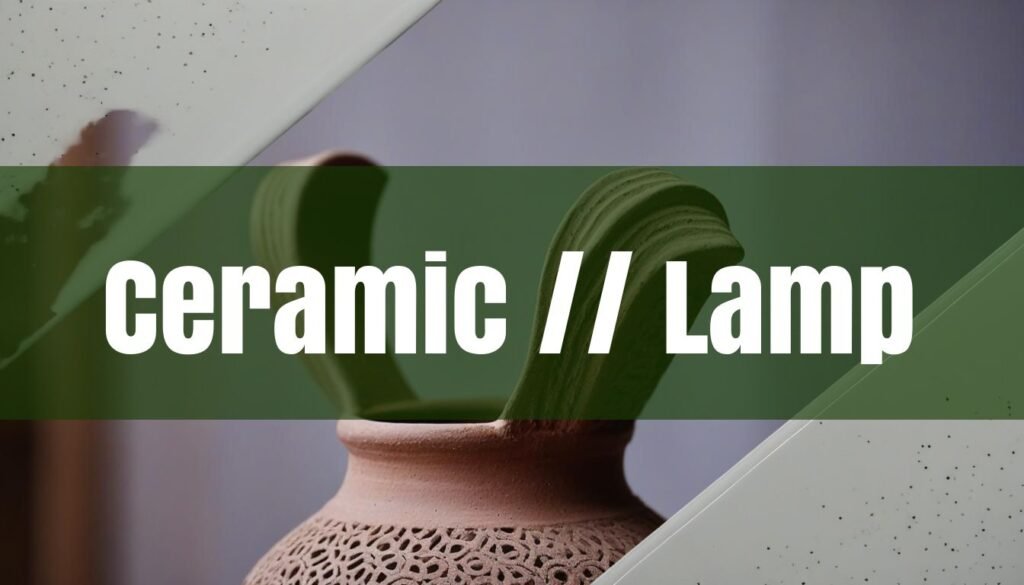Creating a ceramic lamp is a rewarding project that combines artistry with functionality. From selecting the right clay to wiring the final product, each step offers an opportunity to personalize your creation. This guide will walk you through the process of crafting a ceramic lamp, providing detailed instructions and helpful tips along the way.
Choosing the Right Clay
The foundation of any ceramic lamp is the clay. Different types of clay offer varying properties, firing temperatures, and aesthetic results. Understanding these differences is crucial for selecting the best clay for your project. Earthenware clay is a popular choice for beginners due to its forgiving nature and lower firing temperatures, typically between 1,800 and 2,200 degrees Fahrenheit ( Empyrean Pottery). It is easy to work with and ideal for creating simple shapes. However, earthenware is porous and less durable compared to other clay types, requiring glazing to become waterproof (Soul Ceramics). Terracotta, a type of earthenware, is known for its reddish-brown color and is fired between 1745°F (950°C) and 2012°F (1100°C) (Soul Ceramics).
Stoneware clay is a mid-to-high fire clay, typically fired between 2,300 and 2,400 degrees Fahrenheit, offering increased strength and durability (Empyrean Pottery). It is suitable for functional items like cooking pots and vases, and its lower porosity makes it a better choice for items that will hold liquids (Empyrean Pottery). High-fire stoneware becomes hard, vitrified, and non-absorbent when fired, making it extremely durable (Soul Ceramics).
Porcelain clay is the strongest and most durable option, fired at temperatures between 2,400 and 2,600 degrees Fahrenheit (Empyrean Pottery). Known for its delicate appearance and translucent finish when fired at high temperatures, porcelain requires a high degree of skill to shape and form (Pottery Boston). It is often used for fine art objects and tableware due to its non-porous nature (Empyrean Pottery). Other specialized clays, such as paper clay (a mixture of clay and paper pulp), offer increased strength and reduce warping during drying and firing, making them suitable for larger pieces (The Ceramic Shop). To delve deeper into the characteristics of different clays, see this guide comparing earthenware, stoneware, and porcelain. Understanding clay preparation, including mastering wedging techniques, is also essential for achieving the best results in your ceramic projects.
Essential Tools and Equipment
To embark on your ceramic lamp project, you’ll need a range of tools and equipment. Pottery tools are essential for shaping and refining the clay. These include knives, ribs, sponges, and scoring tools for shaping and smoothing the clay (Bailey Pottery). Cut-off wires are useful for removing excess clay, while sanding and abrasive tools help refine the surface (Bailey Pottery). For those using a pottery wheel, throwing sticks and calipers can aid in shaping and measuring the clay (Bailey Pottery).
When it comes to wiring the lamp, several tools are essential for safety and efficiency. Klein tools are highly recommended for their quality and durability (Antique Lamp Supply). These include wire strippers, pliers (such as long-nose and diagonal-cutting pliers), and screwdrivers (Antique Lamp Supply). Hemostat pliers are also useful for handling small parts (Antique Lamp Supply). Additionally, you’ll need a lamp kit, which typically includes a socket, cord, and other necessary electrical components (Clay Planet). Safety gear is also crucial during the wiring process, including PVC electrical tape and an electrical test kit to ensure proper connections and prevent electrical hazards (Antique Lamp Supply).
Crafting the Ceramic Lamp Base
Creating the ceramic lamp base involves several key steps: shaping, drying, firing, and glazing. Whether you choose to use a pottery wheel or hand-building techniques, the process begins with preparing the clay. Place the clay on a clean surface and knead it until it becomes soft and pliable, removing any air bubbles to prevent cracks during firing (Hiro’s Arts). Keep your hands and the clay moist to maintain workability (Hiro’s Arts). If using a pottery wheel, center the clay and gently mold it into your desired shape and size (Hiro’s Arts). For hand-building, use clay cutting tools to create your desired shape (Hiro’s Arts). Remember to create a hole at the bottom of the base for the lamp cord (Hiro’s Arts).
Once the base is shaped, allow it to air dry until it is firm enough to hold its shape (Hiro’s Arts). Use a sponge, rib, and loop to smooth out any rough spots or uneven surfaces (Hiro’s Arts). Refine any patterns or textures with sculpting tools for a crisp look (Hiro’s Arts). Let the clay dry completely before firing (Hiro’s Arts). The first firing, known as bisque firing, makes the clay porous and ready for glazing (Hiro’s Arts). Place the lamp base carefully in the kiln, ensuring it doesn’t touch anything else (Hiro’s Arts). Bisque firing temperatures typically range from 1650°F to 1940°F (900°C to 1060°C), depending on the clay type (Hiro’s Arts). The process takes around 10 to 12 hours, and it’s crucial to let the kiln cool down slowly to prevent cracks (Hiro’s Arts).
After the bisque firing, you can apply underglaze or glaze to decorate the lamp base (Hiro’s Arts). Keep the bottom of the piece free from glaze to prevent drips during the final firing (Hiro’s Arts). The glaze firing is done at a higher temperature, typically around 2232°F (1220°C), to set the glaze and give the lamp its final color and finish (Hiro’s Arts).
Wiring and Final Assembly
Wiring the ceramic lamp requires careful attention to safety and detail. Begin by feeding the lamp cord through the hole in the base (Hiro’s Arts). Use an 18-gauge wire, which is the industry standard for most portable interior lamps (Instructables). Lamp cord typically comes with two or three wires: two wires (hot and neutral) indicated as 18/2, or three wires (hot, neutral, and ground) indicated as 18/3 (Instructables). Most modern lamps do not require a ground wire due to improved designs that isolate the electrical components from touchable parts (Instructables). Connect the wires from the lamp socket to the electrical wires, ensuring all connections are secure (Hiro’s Arts).
The hot wire is typically black, and the neutral wire is white (Color Cord). Connect the black wire to the gold screw and the white wire to the silver screw on the socket (Color Cord). If using a three-wire cord, the green wire is the ground wire, which can be cut off if not needed (Instructables). Secure the socket to the top of the lamp base, using glue if necessary (Hiro’s Arts). Attach a lampshade that complements the lamp’s style and size, securing it with a lamp harp if needed (Hiro’s Arts). Finally, screw in the light bulb and plug the lamp into an outlet to test it (Hiro’s Arts). If everything is wired correctly, your ceramic lamp should light up, providing a warm and satisfying glow (Hiro’s Arts).
Decorative Techniques for Ceramic Lamps
Enhancing the aesthetic appeal of your ceramic lamp involves various decorative techniques, such as carving, painting, and applying textures. Carving can add intricate details and patterns to the lamp base (Hiro’s Arts). Sculpting tools can be used to create unique designs and textures, making each lamp one-of-a-kind (Hiro’s Arts). Painting is another effective way to customize the lamp. Acrylic paints specifically formulated for ceramics are ideal (Noting Grace). Applying the paint with a foam brush in a stippling effect can create a stone-like finish (Noting Grace). Spray paint can also be used, especially for adding bold colors to the base (Eclectic Twist). However, it is not recommended for lamps with a sheen (Eclectic Twist).
Textures can be added using various tools and techniques. Texture rollers and stamps can create repeating patterns, while sgraffito tools can be used to scratch through a top layer of glaze to reveal the clay underneath (Bailey Pottery). Incorporating different decorative elements allows for endless creative possibilities, ensuring that your ceramic lamp is a unique and personalized piece of art (Porch Daydreamer). For more inspiration, explore different glazing techniques and consider using resist techniques to create unique patterns. Additionally, exploring various pottery textures can add depth and character to your lamp design.





